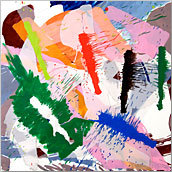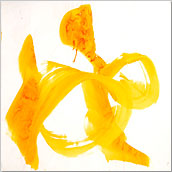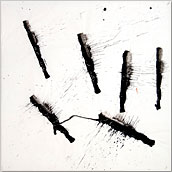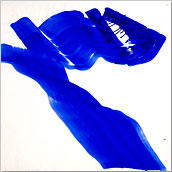ELLEN PRIEST
Creating the “Venezuelan Suite” Paintings 2006-2010
The first step with a new series of paintings is to select a jazz composition I can work and “live” with for one to two years – in this case Edward Simon’s “Venezuelan Suite,” a jazz suite in four movements based on traditional Venezuelan song forms, rhythms and instruments. Choosing music is an ongoing quest for me; I’m always listening for the next projects.
After years of technical experimentation, especially intense in the 1980s, the standard building blocks for my layered, collaged paintings remain papers of varying opacities, saturated colors painted with oil or flashe, and pencil-drawn lines. The translucent papers and oil paint allow one to see, quite literally, a painting through a painting.
I begin work by painting abstract-expressionist brush studies on full-size sheets of paper (usually 42”x 42”) with the music playing. I paint groups of 8-12 studies, working from a stack of paper on my big table, moving quickly, laying the wet studies out on the floor to dry, painting as long as the images stay fresh. My goal is to capture the sounds, rhythms and movement of the jazz composition. I often clamp wide Japanese brushes to a board side-by-side to paint very large gestures.
After several of these sessions spanning days or weeks, I have a large body of studies as raw material for the finished paintings – in the case of the “Venezuelan Suite,” roughly 80. I sort through the studies on my worktable, laying out on the floor images that catch my interest, then moving and turning them to choreograph groups of 3-4 images that will compose one picture.
Next I re-draw the images, tracing and transferring them onto fresh sheets of vellum and watercolor paper. The watercolor paper forms the opaque, stable back layer of each picture, and two sheets of tracing vellum the translucent layers in front.
Starting with the back layer and working forward, I paint into all the layers, hanging them in front of each other periodically to check their activity, deciding where to reinforce forms with collage pieces attached in front or behind.
Color is critical and always dynamic. In my work color establishes the position of forms in space and controls the speed and character of movement. In the “Venezuelan Suite” I use black and white as colors.
Each layer must have compositional integrity, or the space is unconvincing when I pile them up. Color on individual layers is quite restricted. The range of color and value in a painting only becomes full when I pile the layers up. The layers push on each other visually, helping to create the space in the painting.
Up to this point my process is additive. I try to make sure I have all the building blocks in place, balanced and loaded with potential energy.
The subtractive process begins when all layers are painted, constructed, and hung in place over each other. Superfluous sections of the tracing vellum are cut away to reveal colors and forms behind, making them jump forward or back visually, exert new pressures, change direction. This is when I try to set the energy of the whole picture in motion.
Finally I spot-glue the layers in place, weighting them down while they dry.
Left: "Jazz: Edward Simon's 'Venezuelan Suite' #5" with the brush studies used to create it.
© 2007 Ellen Priest
This essay appeared in the exhibition catalog accompanying “ELLEN PRIEST: ‘Jazz Paintings’ on Paper: Improvisations on ‘The Venezuelan Suite’” published by the Philip and Muriel Berman Museum of Art at Ursinus College, 2007.
The first step with a new series of paintings is to select a jazz composition I can work and “live” with for one to two years – in this case Edward Simon’s “Venezuelan Suite,” a jazz suite in four movements based on traditional Venezuelan song forms, rhythms and instruments. Choosing music is an ongoing quest for me; I’m always listening for the next projects.
After years of technical experimentation, especially intense in the 1980s, the standard building blocks for my layered, collaged paintings remain papers of varying opacities, saturated colors painted with oil or flashe, and pencil-drawn lines. The translucent papers and oil paint allow one to see, quite literally, a painting through a painting.
I begin work by painting abstract-expressionist brush studies on full-size sheets of paper (usually 42”x 42”) with the music playing. I paint groups of 8-12 studies, working from a stack of paper on my big table, moving quickly, laying the wet studies out on the floor to dry, painting as long as the images stay fresh. My goal is to capture the sounds, rhythms and movement of the jazz composition. I often clamp wide Japanese brushes to a board side-by-side to paint very large gestures.
After several of these sessions spanning days or weeks, I have a large body of studies as raw material for the finished paintings – in the case of the “Venezuelan Suite,” roughly 80. I sort through the studies on my worktable, laying out on the floor images that catch my interest, then moving and turning them to choreograph groups of 3-4 images that will compose one picture.
Next I re-draw the images, tracing and transferring them onto fresh sheets of vellum and watercolor paper. The watercolor paper forms the opaque, stable back layer of each picture, and two sheets of tracing vellum the translucent layers in front.
Starting with the back layer and working forward, I paint into all the layers, hanging them in front of each other periodically to check their activity, deciding where to reinforce forms with collage pieces attached in front or behind.
Color is critical and always dynamic. In my work color establishes the position of forms in space and controls the speed and character of movement. In the “Venezuelan Suite” I use black and white as colors.
Each layer must have compositional integrity, or the space is unconvincing when I pile them up. Color on individual layers is quite restricted. The range of color and value in a painting only becomes full when I pile the layers up. The layers push on each other visually, helping to create the space in the painting.
Up to this point my process is additive. I try to make sure I have all the building blocks in place, balanced and loaded with potential energy.
The subtractive process begins when all layers are painted, constructed, and hung in place over each other. Superfluous sections of the tracing vellum are cut away to reveal colors and forms behind, making them jump forward or back visually, exert new pressures, change direction. This is when I try to set the energy of the whole picture in motion.
Finally I spot-glue the layers in place, weighting them down while they dry.
Left: "Jazz: Edward Simon's 'Venezuelan Suite' #5" with the brush studies used to create it.
© 2007 Ellen Priest
This essay appeared in the exhibition catalog accompanying “ELLEN PRIEST: ‘Jazz Paintings’ on Paper: Improvisations on ‘The Venezuelan Suite’” published by the Philip and Muriel Berman Museum of Art at Ursinus College, 2007.



